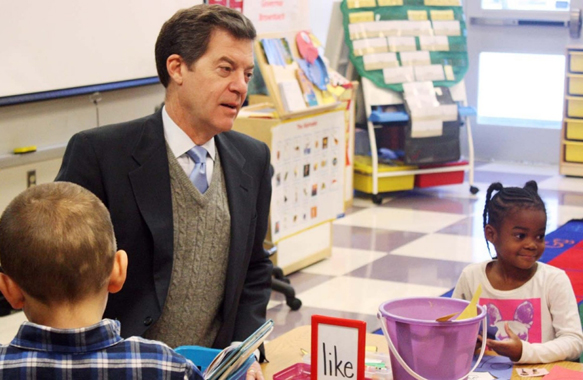Kansas Gov. Sam Brownback listens to kindergarten students during a class on Jan. 23 at Roesland Elementary School in Roeland Park, Ks.John Milburn/AP
Originally Published at Education Justice. March 14, 2014 | The Luke Gannon v. State of Kansas Decision
After a 16-day trial in Gannon v. State of Kansas, a three-judge panel found that the State school funding system was violating the Kansas Constitution. The State appealed, but on March 7, 2014, the Kansas Supreme Court declared that the way in which the State of Kansas funds its K-12 schools is unconstitutional.
The Court’s ruling explains that the Kansas Constitution requires both equity and adequacy in school funding. The Court also set out clear definitions and tests to determine whether the state was complying with these requirements.
Equity
To meet the Kansas Constitution’s equity standard, “school districts must have reasonably equal access to substantially similar educational opportunity through similar tax effort,” the Court wrote.
After reviewing the evidence, the Court affirmed the three-judge panel’s findings that the state has violated the equity standard by shortchanging lower wealth school districts in two ways. “The State established unreasonable, wealth-based disparities,” the court wrote, “by (1) withholding all capital outlay state aid … and (2) prorating all supplemental general state aid.” Capital outlay funds are for buildings and equipment, and supplemental general aid is for general operations.
The Court set a July 1, 2014, deadline for the legislature, which is now in session, to bring these two funding streams into compliance with the equity requirement of the constitution. The associated cost, applying current law, would be about $130 million dollars for the 2014-15 school year.
Read Related Kansas Illegally Underfunds Poorer School Districts, Court Rules and Namesake Father in School Financing Case Driven by Helping Children
Adequacy
While resolution of the equity issues would benefit lower wealth school districts, resolution of the adequacy issue would benefit all districts across the state.
To meet the Kansas Constitution’s adequacy standard, the Court explained that “the public education financing system provided by the legislature for grades K-12—through structure and implementation—
These are strong standards, which require Kansas instruction to be designed to achieve the following goals for all students:
- development of sufficient oral and written communication skills which enable students to function in a complex and rapidly changing society;
- acquisition of sufficient knowledge of economic, social and political systems which enable students to understand the issues that affect the community, state and nation;
- development of students’ mental and physical wellness;
- development of knowledge of the fine arts …;
- training or preparation for advanced training in either academic or vocational fields … to enable student to choose and pursue life work … ;
- development of sufficient levels of academic or vocational skills to enable students to compete favorably in academics and the job market;
- [meeting the] needs of students requiring special education services.
After clarifying the adequacy requirement, the Supreme Court remanded the Gannon case to the three-judge panel to make findings on adequacy using the Rose standards. The panel must “determine whether the State met its duty to provide adequacy in public education … .”
State Defenses
In its defense in Gannon, the State argued that the plaintiffs did not have standing to bring the case, and the funding issues were non-justiciable, that is, not subject to judicial review. The Court found that the school districts had standing, as they alleged that state underfunding interferes with their duties to “maintain, develop, and operate the local public school systems,” as set out in the Kansas Constitution.
The Court also held that the issues were justiciable, quoting parallel rulings by the Texas Supreme Court and other state supreme courts on the justiciability question. The Court explained that the Kansas Constitution assigns to the judiciary the duty and responsibility to interpret the constitution and determine whether acts of the legislature violate it. Citing Kansas precedent from 1870 to 2005, the Court reiterated that, “the judiciary’s sworn duty includes judicial review of legislation for constitutional infirmity.”
The state argued that the legislature had sole decision making authority over school funding, but the Court stated that by assigning a duty to the legislature the constitution both empowers and obligates. The Court also quoted the three-judge panel in Gannon, which wrote, “Matters intended for permanence are placed in constitutions for a reason—to protect them from the vagaries of politics … .”
For further analysis of the Kansas Supreme Court’s decision in Gannon, see Still a Great Decision at plaintiffs’ website.
Related Stories:
Kansas Supreme Court Stands Up for All Kansas Students
Plaintiffs Win In Kansas, State Response May Create Crisis
Education Justice Press Contact:
Molly A. Hunter, Esq.
Director, Education Justice
email: mhunter@edlawcenter.org
voice: 973 624-1815 x19
www.edlawcenter.org
www.educationjustice.org












Leave A Comment